The core of the matter: the scientists using Antarctic ice to understand our climate
28 February, 2025 Long reads, science
Whether it’s bubbles of ancient air, microscopic creatures, or the rumble of an impending ice quake – there’s more hidden in Antarctica’s vast polar desert than meets the eye. Ice core scientists Dr Emma Pearce, Dr Liz Thomas and Dr Dieter Tetzner talk about their work uncovering the secrets of Earth’s past, present and future, frozen in the ice.
Deep in the Antarctic wilderness, often miles away from the nearest research station, teams of scientists are hard at work. Living and working under canvas in chilling sub-zero temperatures, these ice core specialists are drilling for information about the history of our planet.
Ice cores are long cylinders of ice, slightly thicker than a standard 330ml drink can, which have been extracted from an ice sheet, sea ice, or glacier. Using specialised drills that are sent progressively deeper in to the ice, the cores are continuously drilled and brought to the surface, in one or two metre lengths at a time. They are then cut to the same length, labelled, and stored for transportation, ready to be studied in laboratories around the UK, including at British Antarctic Survey (BAS) in Cambridge.
Ice cores are like frozen archives, analysed by researchers from their physical properties to their chemical compositions – providing a snapshot of climate and environmental conditions stretching back thousands of years. The deeper the ice extracted, the older the information stored, allowing scientists to study how our planet functions both now and in the past, and helping them predict changes into the future.
A snapshot of ice fracturing
Emma Pearce, a BAS geophysicist currently working on the RIFT-TIP project, is one such scientist. Her team is using ice cores to investigate ice fracturing dynamics.
“RIFT-TIP stands for Rates of Ice Fracture and Timing of Tabular Iceberg Production– it’s a bit of a mouthful!” she laughs. Based on the Brunt Ice Shelf, the project aims to understand how and why ice shelves fracture, as well as how to predict this fracturing in the future.
“I use physics to study what’s going on inside the ice,” Emma says, “whether that’s by listening to vibrations from the ice caused by fracturing, or breaking ice cores apart in a lab to look at their physical properties.” Explaining why this is important, she added:
“The better we understand ice fracturing and get an overall idea of how glaciers and ice sheets are going to change – as well as what their contribution to sea level rise will be – the better we can inform policymakers to plan and prepare for the changes our planet is going through due to climate change.”
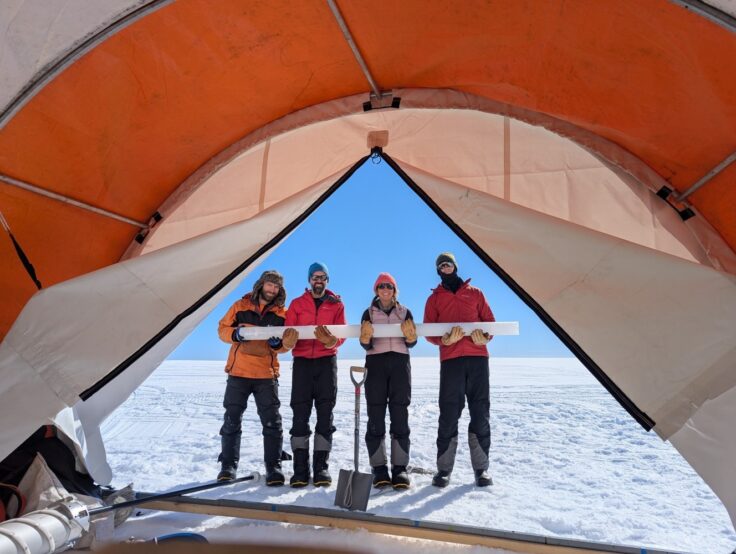
Ice cores are just one part of the RIFT-TIP project. Geophysical data from ground penetrating radar is used to study layers within the ice, allowing Emma and her team to see where seawater infiltrates the ice from below, and to see whether or not there are any cracks in the ice. This means that fractures can be identified beyond the visible surface Seismometers are also used to help the team listen for ice quakes – any movement, or anything causing a vibration through the ice – which gives them an idea of large-scale deformation, like rifts and fractures, which release stress in the ice shelf.
Emma explained how GPS adds to these measurements: “We deploy lots of metal poles, and then really accurately measure where those poles have moved every day, every week, every month that we’re there. If we start seeing our square grid of poles get squashed or rotated, it gives us an idea of how forces are acting on the ice.”
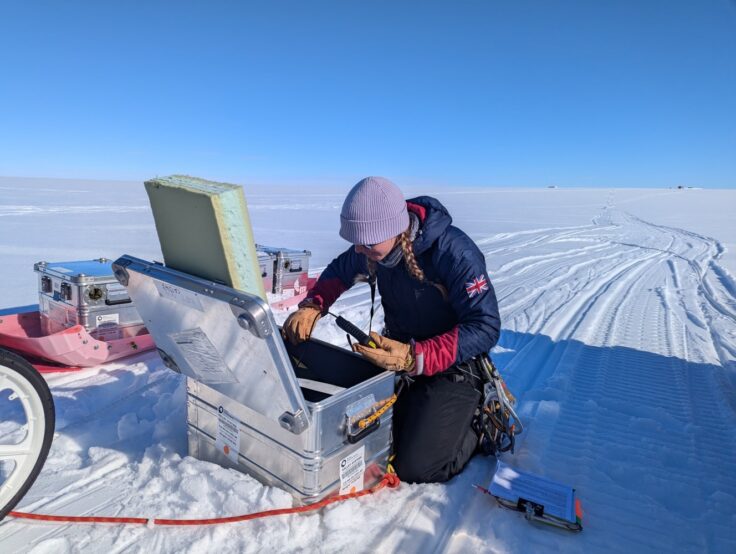
The combination of geophysical methods and ice cores provides the RIFT-TIP project with a more three-dimensional picture than the use of either approach alone.
“Once the field data and ice cores are collected, we bring the cores back to the lab at University College London and fracture them, using high pressure mechanics to break them,” says Emma. “We then look back at high-speed camera recordings of the snap and can see exactly how the ice breaks.”
The ice will be further analysed for its physical properties, like ice crystal structure, to provide a small-scale view of ice fracturing mechanisms. Combined with the other geophysical data collected – which explores these mechanisms on a broader scale – a more detailed and holistic understanding can be reached.
Emma says, “it’s quite hard to model the process of iceberg fracturing as the mechanisms behind it aren’t just one simple process, making it difficult for us to model precisely. With the new insights from RIFT-TIP, using data from several different angles, we hope ice sheet modelling predictions will improve, which is important because fracture-induced instability in ice is the largest uncertainty in sea level projections. These projections are used to plan coastal adaptations worldwide, so inaccuracies can have serious consequences for people living in coastal areas around the world.”
A window deep into time
Elsewhere on the Antarctic continent, ice cores are used to understand climate change over millennia. Liz Thomas is Head of Ice Cores Research at BAS, and a paleoclimatologist, specialising in how the polar climate has changed from the ancient past until now. Her research is used to scrutinise our current climate, monitoring patterns or changes which have been observed in the past, and which may have consequences for the future.
Liz is working on a project called REWIND. “Our aim is to understand how the wind patterns – or atmospheric circulation – around Antarctica have changed, and how sea ice has changed over the same time,” she explains. “We’re going to combine that with a new record of carbon dioxide, which we can extract from the air bubbles within ice cores. Linking those three things can help us understand how the Southern Ocean affects how much carbon dioxide (CO₂) we have in the atmosphere”.
Over 40% of the CO₂ which occurs due to human activity – known as anthropogenic CO₂ – is currently absorbed from the atmosphere by the Southern Ocean, which acts as a ‘sink’ or ‘sponge’.
However, the amount the ocean is able to absorb depends on physical processes like sea ice, and wind. As sea ice melts, there is a greater capacity for water to mix due to large waves and bubbles on the surface being generated by strong winds. This could result in the ocean acting as a source of CO₂ – releasing it back into the atmosphere rather than absorbing it.

The extent to which the Southern Ocean will act as a source or sink in the future remains a major uncertainty in climate research – something Liz and her team are hoping to change. Looking back through previous periods where there were significant changes in winds or sea ice could give us crucial insight into how the Southern Ocean will behave in response to the rise in atmospheric CO₂.
Liz explains: “It’s processes similar to these that contribute to ice melt and sea level rise. So we’re looking into these things to really understand the whole system. Sometimes, we’re working with quite a simplified picture when we talk about how the climate is changing.” Liz spelled out the problem:
“Often, we only talk about temperature – but what we should be worried about is how the carbon dioxide, in time, will trigger all these other processes: increased melting of ice sheets, rises in sea level. It’s all connected, and we want to understand how”.
The REWIND team is drilling deep into the ice sheet on the Antarctic Peninsula, to a depth of approximately 800 metres. Around 12 tonnes of cargo, supported by the ship the RRS Sir David Attenborough, as well as BAS’s fleet of ski-equipped Twin Otter aircraft, will be brought into the field to complete the work.
The huge scale of this project is one of the reasons REWIND takes place over at least two seasons – first, setting up an established camp and shallow drilling to around 60 or 70 metres, then returning to finish the deeper drilling the next year. This is made all the more challenging by the location along the Antarctic Peninsula, 30-40 kilometres from the UK’s remote Sky Blu Field Station.
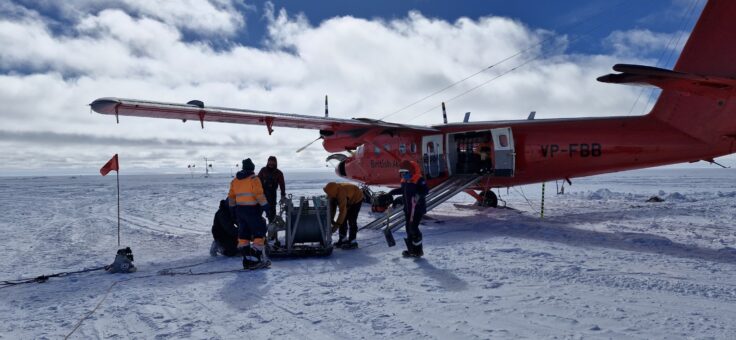
Although Antarctica has an abundance of ice, not all ice is created equal, hence the challenging location. “It’s all about getting the best resolution,” Liz confirms. In ice core terms, the resolution is the level of detail (and therefore, precision) the information in an ice core can provide.
“Our drill site is the place with the best resolution for what we want to investigate across all of Antarctica – and that is due to the amount of snowfall,” she explains. “The more snowfall we can get, the more information is trapped, and the higher resolution.” Liz continues:
“Over time, the snow gets highly compressed to form layers of ice which trap an annual record of information – from ten, to tens of thousands of years ago. In order to extract that information, to achieve a high resolution of data year by year, we needed to drill somewhere where there’s high, reliable, constant snowfall to make sure there’s enough data for us to isolate and effectively process.”
In addition, the Antarctic Peninsula is highly sensitive to current climate change.” says Liz. “That’s why I’ve worked in the Peninsula for the last 20 years – if it’s most sensitive to the changes we’re seeing now, then it’s almost a guarantee that it would be behaving much more dynamically to changes in the past as well.”
Liz adds that a major draw of the area is the quality of data about the atmosphere trapped in the ice. Ice cores can capture information from many thousands of kilometres away, telling scientists about the climate of an entire region, or even the entire Antarctic continent.
“Antarctic ice is the sky’s memory,” Liz summarises eloquently. “From good things, like the oxygen we breathe, to less good things like pollutants and microplastics, everything finds its way to the ice sheet by being deposited from the atmosphere.”
“Nothing that’s trapped in the Antarctic ice has really been disturbed, it’s not mixed with anything else, it’s clean,” she says. “By studying them we can essentially hop in a time machine and see a record of our atmosphere spanning millions of years. That’s why ice cores are, by far and away, the best type of environmental archive you can get.”
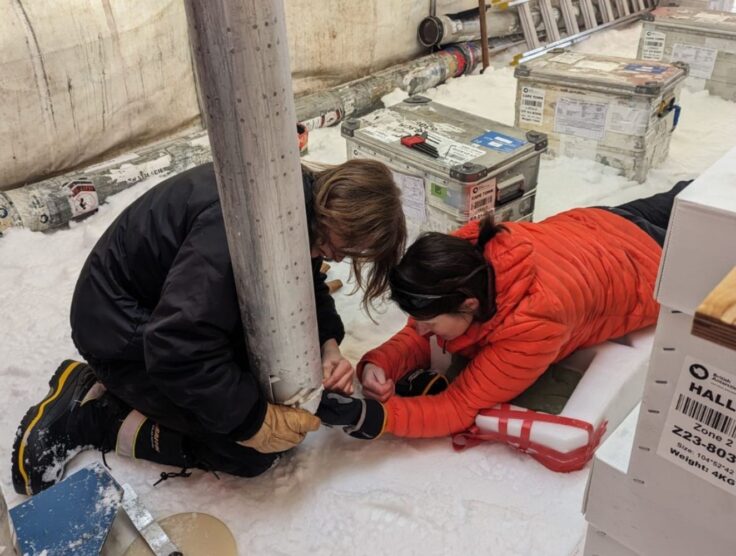
When the ice cores reach the lab, the focus will be on releasing the material trapped within them. Each core will be cut into long sections, 3cm x 3cm thick, and placed on a hotplate for a slow and controlled melt. The meltwater flows into multiple analytical instruments, generating a continuous record of the chemical composition of the ice moving through time.
The upper, younger layers of ice are melted relatively quickly compared to the lower layers, because scientists have accurate, consistent climate records from previous projects and studies. Additionally, these upper layers are less compressed and so are easier to distinguish, usually from year to year.
“With the lower layers, we want the melting to happen incredibly slowly,” points out Liz, “to try and extract as much information as possible from the tiniest amount of ice. With such old, highly compressed ice, we’re looking more at century-to-century chronology – fundamentally, one of the most important things we have to get right is the age scale.”
The deeper you delve into the ice, the more that dating layers accurately becomes a challenge. Scientists can generally gauge how many layers to expect within a certain depth, but the older the ice, the more that educated estimates (often computer models) are relied upon. Computer modelling is often created with the help of previous ice core data, as well as matched records from other existing sources – like sediment cores.
Like their icy cousins, sediment cores reveal patterns of the Earth’s history with the material they capture. Drilled from earth and mud, often from a lake or the ocean, sediment cores tell us what happened in a particular place by studying the material that has fallen into them and been captured by the core.
“Some sediment cores hold information that is 5 million years old, so there’s a real advantage to being able to use both records together,” she says. “We’re using as many of these sources from the last 30 years of research as we can, building on our knowledge base using these sources as tools. That’s what gets us the best results.”
Reaching the oldest ice
Melting very thin layers of ice will become extremely important for the team’s next big endeavour, as they take on the challenge of analysing the oldest ever Antarctic ice core.
This autumn, Liz and her team is leading the chemical analysis of the Beyond EPICA – Oldest Ice core. This EU funded drilling project, which uses similar methods to REWIND but on a much larger scale, is an extension of a previous programme called EPICA (European Project for Ice Coring in Antarctica). With more modern technology, this sequel seeks to uncover climate data from 1.2 million years ago – a significant extension of the original EPICA’s 800,000-year-old sample.
The ice core from this project will be 2.8 kilometres long, with drilling so deep that it will reach through the East Antarctic ice sheet, down to the bedrock. It is hoped that the project will unveil, for the first time, a continuous record of Earth’s past atmosphere and climate, stretching back 1.2 million years, and potentially beyond.
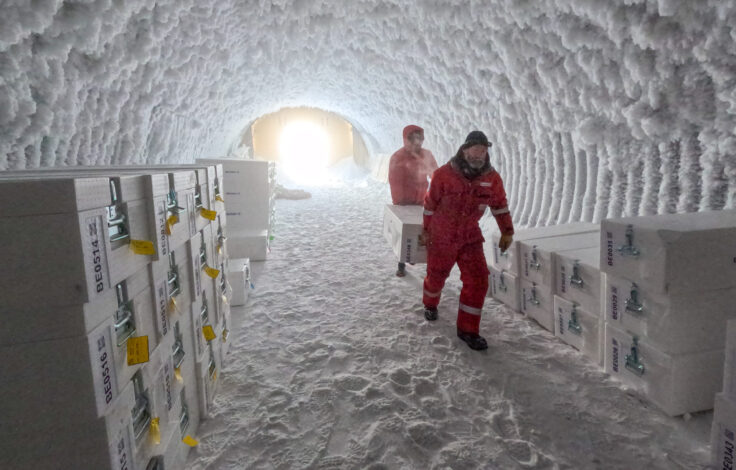
With such ambitious aims, and incredibly challenging conditions – like working at altitudes of approximately 3,200 metres (10,500 feet) above sea level, in average field temperatures of -35°C – the project is an international effort. Coordinated by the Institute of Polar Sciences of the Italian National Research Council, the project is a collaboration involving twelve scientific institutions (including BAS) from ten European nations, all working to ensure the project is a success. The latest update from the field team has seen them complete the drilling phase, sampling the oldest continuous ice record on Earth for the first time in history.
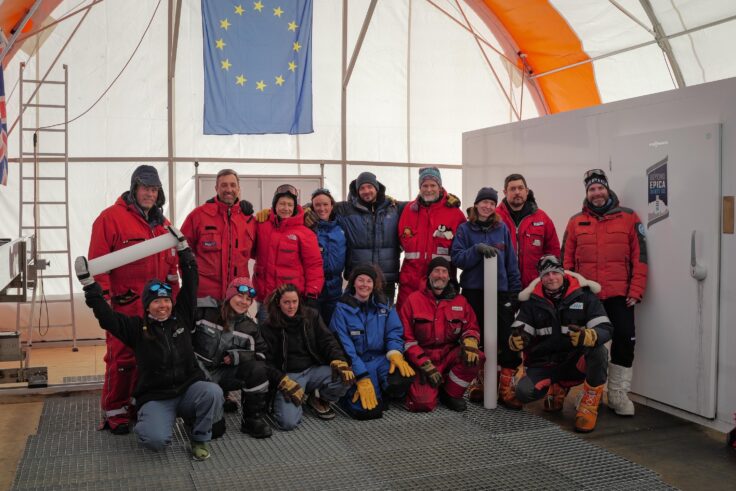
Reconstructing winds of the past
With Beyond EPICA’s focus on ice that has never before been seen or studied by humans, modelling and use of other sources are necessary to fill in knowledge gaps and paint a fuller picture. Dieter Tetzner, a BAS ice core scientist whose research focuses on tiny phytoplankton called diatoms, details how sometimes scientists need to be creative when investigating their chosen subjects.
“One of the hardest factors to account for is wind,” says Dieter. “So we’re looking at the problem from a completely different angle by investigating diatoms – organisms that live in almost all of the world’s aquatic environments – instead of the winds directly.
“Antarctica has almost no liquid water in its interior, it’s dry. Yet we still find diatom dead cells whenever we analyse the ice – like a cemetery full of them, hundreds of kilometres away from their aquatic habitats.”
The presence of these tiny microorganisms in the ice sheet is a mystery to scientists, who still don’t fully understand how they make their way to where they are found in Antarctic ice, through the many, many layers of ice.
“They are somehow connected with the wind strength over the areas where we think they are sourced from,” he explains. “By analysing the diatoms, we’ve so far been able to link them to the strength of the winds. The stronger the winds over the ocean, the more diatoms we end up finding in the ice. What we’re really doing, as we can’t measure or observe past winds directly, is using the diatoms as a proxy. We think we’ve found an indirect way of looking at the past.”
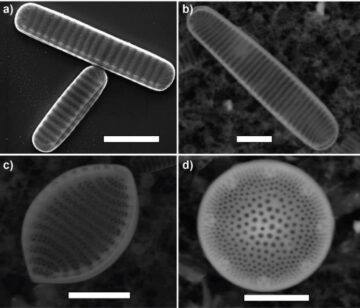
Dieter explains how not all the details of this particular method have been figured out: “We know that the diatom record is likely to be mediated by the winds – but there are many things we don’t know. We also need to also understand the processes that are creating it.”
The working theory is that strong winds create larger ocean waves and more splashing, which removes diatoms from the surface. They then travel afloat on these winds as aerosols – particles in the atmosphere – until they are deposited once they reach the ice. However, there are components of this process which remain uncertain – and that the team aims to shed light on, thanks to ice cores drilled for REWIND.
“We’re going to be researching from the RRS Sir David Attenborough,” smiles Dieter, “sampling the seawater around it as it moves, to see exactly what diatoms are present. Then we will sample the air to see what aerosols are present around the ship. By comparing these and recording the environmental conditions like ‘strong winds’ or ‘large waves’, we’ll be able to tell what is being actively pulled from the ocean and how.”
He continues: “This will allow us to control for how many diatoms we get for each environmental condition, and figure out if it’s true that these strong winds are what is removing large amounts of diatoms from the ocean. Finally, we’ll track what diatoms are deposited at the same time as our data from the ship by looking at what is present in the REWIND ice cores, hopefully reconstructing the winds more accurately than we’ve ever done before.”
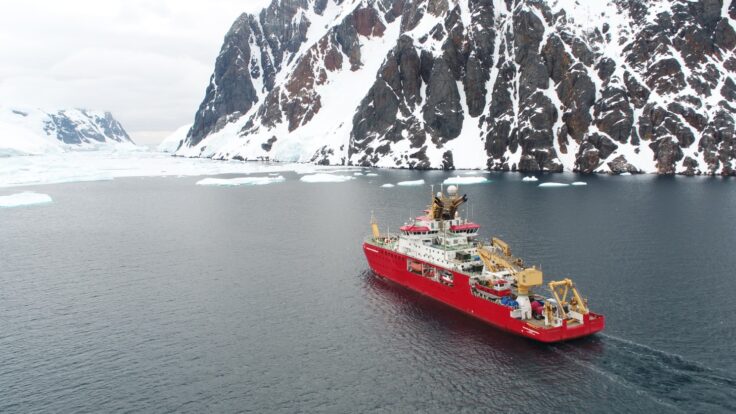
Other considerations within this already complex project are types of diatoms studied, and time of year. As diatoms are a type of phytoplankton, or algae, their communities contract during the harsh Antarctic winter, then explode during the summer season under conditions more conducive to photosynthesis.
“As one of the most diverse sorts of cells,” says Dieter, “one of the other things we want to explore is the communities afloat near the ship. We’re looking into whether they’re the same ones that we’re finding in the ice 500 kilometres away, or if there is an abundance of one species over another.”
So, this project is very interdisciplinary. “It’s a bit of what biologists do, with sampling things from the water; it’s a bit of atmospheric sciences; and then we also fall into the ice cores team to study where these microorganisms end up. It’s a very detailed campaign of observations to study a process that, so far, we are only making inferences about. It’s dependent on many variables so we can – only with these methods used collectively – harvest the diatom record and get an idea of how the environment has changed back in time. It makes diatoms a very unique and special record compared to others.”
This project is the very first of its kind – making BAS the first polar science institution to measure winds in this way, and Dieter one of the researchers at the forefront of world-leading research. He adds, modestly:
“Everything we discover strengthens what we’re doing, builds on what has come before, and informs research that will occur in the future.
That’s why this project is being conducted in parallel with the REWIND project. REWIND is the star, but these findings will feed information into it, making it more robust. And in return they will give us a better idea and understanding of how winds changed in the past.”
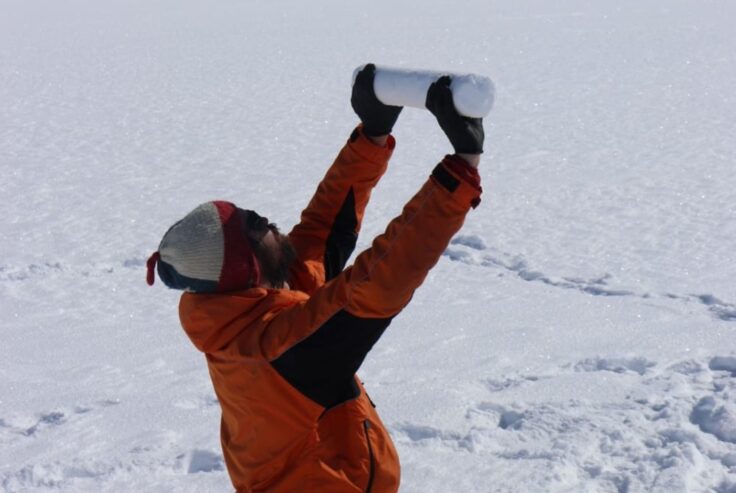
Ice cores are incredibly versatile, which makes them such fascinating subjects of study – and such valuable tools of change. With scientists from multiple fields able to collect an array of information from ice cores, one project is able to inform another, which informs another, and another.
The discoveries made with these projects means scientists are able to weave a rich tapestry of information together, that, by standing back to view as a whole, creates a clearer, more detailed image than any one project can alone. In the case of ice cores, they act as an analogue of change; the ice core tapestry reveals a multidimensional understanding of Earth’s environment and climate functions, informing us of what is happening now.
Vitally, this is also what allows us to recognise which areas are able to be targeted for improvement the world over, informing policymakers and Governments on our planet’s response to climate change. Ice cores are studied for our benefit, and the benefit of our planet – to help scientists like Emma, Liz, and Dieter continue uncovering the mysteries of our planet, learning how it’s changing, predicting what might happen in the future, and protecting Antarctica for the next generation.